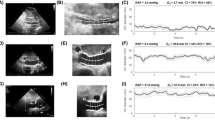Abstract
Purpose
It is recommended in current guidelines that the inferior vena cava (IVC) diameter should be measured at 1.0–2.0 cm from the junction with the right atrium. However, right atrial pressure (RAP) is underestimated in some patients who have a small IVC diameter (IVCD) because of a high-echo structure compressing the IVC from the back at that portion. The aim of this study was to identify the structure behind the IVC and to evaluate its influence on RAP.
Methods
We retrospectively studied 116 patients who underwent right-heart catheterization. We reviewed computed tomography (CT) scans and analyzed the relation between RAP and IVCD measured by echocardiography not only in the way recommended in the guidelines, but also in a way that avoided the structure.
Results
CT scans revealed that the diaphragm, not the vertebra, was located just behind the IVC in most patients. Sixteen patients (13.8%) had RAP ≥ 10 mmHg. In those patients, when IVCs were measured in a way that avoided the diaphragm, IVCDmax diameter was larger and IVC collapsibility index (IVCCI) tended to be smaller than those when IVCDs were measured according to the guideline methods. The sensitivity of IVCD to predict RAP ≥ 10 mmHg (IVCDmax > 21 mm, IVCCI < 50%) increased from 31.3% to 68.8% with our method.
Conclusions
The high-echo structure pushing the IVC from the back is the diaphragm in most patients. It might be better to measure IVCD using a method that avoids the diaphragm to accurately estimate RAP.





Similar content being viewed by others
References
Ponikowski P, Voors AA, Anker SD, et al. 2016 ESC Guidelines for the diagnosis and treatment of acute and chronic heart failure: The Task Force for the diagnosis and treatment of acute and chronic heart failure of the European Society of Cardiology (ESC) Developed with the special contribution of the Heart Failure Association (HFA) of the ESC. Eur Heart J. 2016;37:2129–200.
Yancy CW, Jessup M, Bozkurt B, et al. 2013 ACCF/AHA guideline for the management of heart failure: executive summary: a report of the American College of Cardiology Foundation/American Heart Association Task Force on practice guidelines. Circulation. 2013;128:1810–52.
Lang RM, Badano LP, Mor-Avi V, et al. Recommendations for cardiac chamber quantification by echocardiography in adults: an update from the American Society of Echocardiography and the European Association of Cardiovascular Imaging. J Am Soc Echocardiogr. 2015;28(1–39):e14.
Tucker WD, Burns B. Anatomy, abdomen and pelvis, inferior vena cava. In: StatPearls. Treasure Island (FL): StatPearls; 2019.
Zoghbi WA, Adams D, Bonow RO, et al. Recommendations for Noninvasive Evaluation of Native Valvular Regurgitation: A Report from the American Society of Echocardiography Developed in Collaboration with the Society for Cardiovascular Magnetic Resonance. J Am Soc Echocardiogr. 2017;30:303–71.
Simonson JS, Schiller NB. Sonospirometry: a new method for noninvasive estimation of mean right atrial pressure based on two-dimensional echographic measurements of the inferior vena cava during measured inspiration. J Am Coll Cardiol. 1988;11:557–64.
Jue J, Chung W, Schiller NB. Does inferior vena cava size predict right atrial pressures in patients receiving mechanical ventilation? J Am Soc Echocardiogr. 1992;5:613–9.
Pearson AA, Sauter RW, Oler RC. Relationship of the diaphragm to the inferior vena cava in human embryos and fetuses. Thorax. 1971;26:348–53.
Downey R. Anatomy of the normal diaphragm. Thorac Surg Clin. 2011;21(273–9):ix.
du Plessis M, Ramai D, Shah S, et al. The clinical anatomy of the musculotendinous part of the diaphragm. Surg Radiol Anat. 2015;37:1013–20.
Boriek AM, Rodarte JR. Effects of transverse fiber stiffness and central tendon on displacement and shape of a simple diaphragm model. J Appl Physiol. 1985;1997:1626–36.
Teismann NA, Ching B, Shyy W, et al. Technical Pitfalls in Sonography of the Inferior Vena Cava: Beware the Diaphragm. J Ultrasound Med. 2017;36:1071–2.
Goldhammer E, Mesnick N, Abinader EG, et al. Dilated inferior vena cava: a common echocardiographic finding in highly trained elite athletes. J Am Soc Echocardiogr. 1999;12:988–93.
Brennan JM, Blair JE, Goonewardena S, et al. Reappraisal of the use of inferior vena cava for estimating right atrial pressure. J Am Soc Echocardiogr. 2007;20:857–61.
Mannarino S, Bulzomi P, Codazzi AC, et al. Inferior vena cava, abdominal aorta, and IVC-to-aorta ratio in healthy Caucasian children: Ultrasound Z-scores according to BSA and age. J Cardiol. 2019;74:388–93.
Taniguchi T, Ohtani T, Nakatani S, et al. Impact of Body Size on Inferior Vena Cava Parameters for Estimating Right Atrial Pressure: A Need for Standardization? J Am Soc Echocardiogr. 2015;28:1420–7.
Kawata T, Daimon M, Lee SL, et al. Reconsideration of Inferior Vena Cava Parameters for Estimating Right Atrial Pressure in an East Asian Population- Comparative Simultaneous Ultrasound-Catheterization Study. Circ J. 2017;81:346–52.
Ciozda W, Kedan I, Kehl DW, et al. The efficacy of sonographic measurement of inferior vena cava diameter as an estimate of central venous pressure. Cardiovasc Ultrasound. 2016;14:33.
Acknowledgements
The authors thank Ms. Natsuki Yoshimoto, Ms. Saori Murata, Ms. Yasuko Jinzenji, Ms. Ayumi Shimizu, and Ms. Tomono Okada for their assistance with data collection. Y Baba, J Kawaguchi, Y Ochi, T Kubo, and H Kitaoka conceived the idea for the study and planned the investigations. Y Baba, J Kawaguchi, T Kubo, T Hirota, and N Yamasaki undertook clinical investigations of patients. Y Baba, J Kawaguchi, D Hirakawa, and Y Ochi examined echocardiography. Y Baba, J Kawaguchi, K Miyagawa, and T Noguchi performed right-heart catheterization. T Oryu performed CT scans and reconstructed three-dimensional CT imaging.
Author information
Authors and Affiliations
Corresponding author
Ethics declarations
Conflict of interest
The authors declare that there are no conflicts of interest.
Ethical approval
The study protocol was approved by the Ethical Review Board of Kochi Medical School, Kochi University. (approval number: 31–113).
Additional information
Publisher's Note
Springer Nature remains neutral with regard to jurisdictional claims in published maps and institutional affiliations.
About this article
Cite this article
Baba, Y., Kawaguchi, J., Ochi, Y. et al. The diaphragm affects echocardiographic measurement of inferior vena cava diameter to predict right atrial pressure. J Med Ultrasonics 47, 565–573 (2020). https://doi.org/10.1007/s10396-020-01047-1
Received:
Accepted:
Published:
Issue Date:
DOI: https://doi.org/10.1007/s10396-020-01047-1




